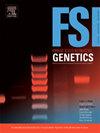SCN5A missense variants and their contribution to deaths in Sudden Unexplained Nocturnal Death Syndrome (SUNDS)
IF 3.1
2区 医学
Q2 GENETICS & HEREDITY
引用次数: 0
Abstract
Sudden Unexplained Nocturnal Death Syndrome (SUNDS), locally known as Lai-tai in Thailand, leads to sudden death during sleep in otherwise healthy young males. Cardiac arrhythmias, including Brugada syndrome (BrS) and Long QT syndrome (LQTS), are often implicated, with mutations in the SCN5A gene, encoding the Nav1.5 sodium channel, strongly linked to both conditions. This study characterized postmortem SUNDS cases in Thailand and analyzed SCN5A gene variants using whole exome sequencing (WES) and molecular modeling. Forensic autopsies were performed on 98 SUNDS victims from August 2020 to February 2023. WES was applied to 98 SUNDS-related genes, filtering variants based on dbNSFP annotations and public databases like the 1000 Genomes Project. Three SCN5A variants (A665S, R179Q, and R965C) were detected in five cases (approximate for 5 %). One case of A665S, which was reported for the first time in Thailand, was discovered. The R179Q variant was identified in an additional case, but it did not have a substantial electrostatic surface impact on Nav1.5. In contrast, the R965C variant, which is frequently associated with BrS, was discovered in three cases (approximate for 3 %). These results imply that SCN5A variants are involved in the pathogenesis of SUNDS and may provide valuable genetic markers for the purpose of diagnosis and prevention.
SCN5A错义变异及其对不明原因夜间猝死综合征(SUNDS)患者死亡的影响
原因不明的夜间猝死综合症(SUNDS),在泰国当地被称为Lai-tai,会导致健康的年轻男性在睡眠中猝死。心律失常,包括Brugada综合征(BrS)和长QT综合征(LQTS),通常与SCN5A基因突变有关,编码Nav1.5钠通道,与这两种疾病密切相关。本研究描述了泰国死后的SUNDS病例,并使用全外显子组测序(WES)和分子模型分析了SCN5A基因变异。从2020年8月到2023年2月,对98名sds受害者进行了法医尸检。WES应用于98个sds相关基因,基于dbNSFP注释和1000基因组计划等公共数据库过滤变异。在5例中检测到3种SCN5A变异(A665S、R179Q和R965C)(约为5 %)。发现泰国境内首次报告的A665S病例1例。R179Q型在另一种情况下被确定,但是它对Nav1.5没有实质性的静电表面冲击。相比之下,经常与BrS相关的R965C变异在三个病例中被发现(大约为3 %)。这些结果提示SCN5A变异参与了SUNDS的发病机制,可能为诊断和预防SUNDS提供有价值的遗传标记。
本文章由计算机程序翻译,如有差异,请以英文原文为准。
求助全文
约1分钟内获得全文
求助全文
来源期刊
CiteScore
7.50
自引率
32.30%
发文量
132
审稿时长
11.3 weeks
期刊介绍:
Forensic Science International: Genetics is the premier journal in the field of Forensic Genetics. This branch of Forensic Science can be defined as the application of genetics to human and non-human material (in the sense of a science with the purpose of studying inherited characteristics for the analysis of inter- and intra-specific variations in populations) for the resolution of legal conflicts.
The scope of the journal includes:
Forensic applications of human polymorphism.
Testing of paternity and other family relationships, immigration cases, typing of biological stains and tissues from criminal casework, identification of human remains by DNA testing methodologies.
Description of human polymorphisms of forensic interest, with special interest in DNA polymorphisms.
Autosomal DNA polymorphisms, mini- and microsatellites (or short tandem repeats, STRs), single nucleotide polymorphisms (SNPs), X and Y chromosome polymorphisms, mtDNA polymorphisms, and any other type of DNA variation with potential forensic applications.
Non-human DNA polymorphisms for crime scene investigation.
Population genetics of human polymorphisms of forensic interest.
Population data, especially from DNA polymorphisms of interest for the solution of forensic problems.
DNA typing methodologies and strategies.
Biostatistical methods in forensic genetics.
Evaluation of DNA evidence in forensic problems (such as paternity or immigration cases, criminal casework, identification), classical and new statistical approaches.
Standards in forensic genetics.
Recommendations of regulatory bodies concerning methods, markers, interpretation or strategies or proposals for procedural or technical standards.
Quality control.
Quality control and quality assurance strategies, proficiency testing for DNA typing methodologies.
Criminal DNA databases.
Technical, legal and statistical issues.
General ethical and legal issues related to forensic genetics.

 求助内容:
求助内容: 应助结果提醒方式:
应助结果提醒方式:


